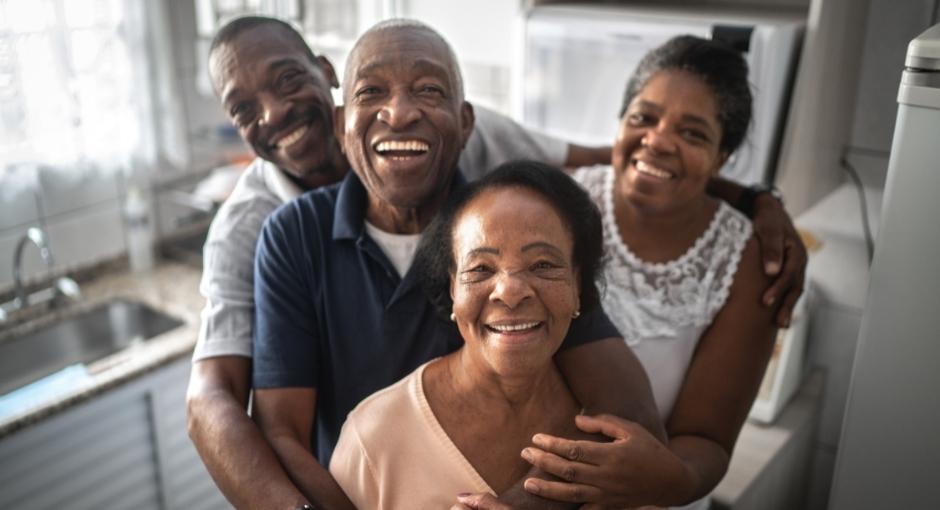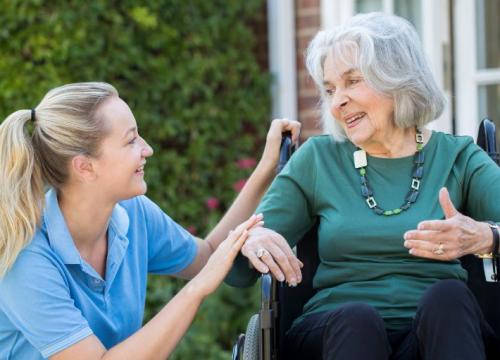Caring for the Care Partner

Life does not stop with a Parkinson’s disease (PD) diagnosis — but PD and its symptoms change over time, as will your role as a care partner. Your challenges and experiences will be unique. However, you are not alone.
You cannot be a good caregiver to someone else without caring for yourself. Taking care of yourself requires finding balance. Regular breaks from caregiving are an essential part of this balance. Take an hour daily, an afternoon weekly or a day monthly — whatever you can manage.
These breaks from daily routines and responsibilities, often called “respite,” are especially important if you are with the person you care for 24 hours a day. Counseling, adult day care, a home health aide, or any other source of help should be looked at as early interventions, not eleventh-hour alternatives.
The most important thing to remember is that the person you are taking care of is only doing as well as you are; if you do not take care of yourself, you will not be able to take care of your loved one.
The Caregiver Burden Continuum
When a care partner does not attend to their own needs or take time off from the caregiving role, they may find themselves on the “Caregiver Burden Continuum.”
Caregiver burnout is a state of physical, emotional and mental exhaustion that may include by a change in attitude, from positive and caring to negative and unconcerned.
Caregiver Burden is a complex, multi-dimensional concept that includes factors that are subjective (based on your own personal experience) and objective (not influenced by your feelings). There are three basic sections of this continuum:
- Caregiver Stress
- Caregiver Strain
- Caregiver Burnout
Where you fall on this continuum depends on your current experience with:
- The distance between the financial resources required to meet your needs and your actual financial resources
- Where you fall on the spectrum between socially active or socially isolated
- How many roles you’re trying to navigate simultaneously with conflicting responsibilities
Caregiver Stress
Caregiver stress is when you experience a manageable amount of stress and anxiety related to caregiving. Caregiver stress is, unfortunately, a part of life when caring for someone with a chronic illness such as PD — especially over an extended period.
Caregiver Strain
As stress and anxiety grows to be less manageable, we start calling it caregiver strain. You have reached this stage when the stress and anxiety begin to impact your ability to care for your loved one.
Caregiver strain is the perception of persistent problems and a feeling of decreased well-being that results from providing prolonged care, according to the Modified Caregiver Strain Index (a screening tool used to measure caregiver strain). This can look like forgetting more tasks than usual, feeling too fatigued to take care of yourself outside of your care duties or becoming more easily frustrated with your loved one.
Care partners can experience caregiver strain for short or long periods of time without realizing it. It is important to you have someone in your life who you can talk to when you are feeling overwhelmed or stressed about caregiving. It is in times like these that having a secondary care partner can be helpful — you can take a break while someone else helps care for your loved one.
Caregiver Burnout
Unaddressed caregiver strain progresses into caregiver burnout. Caregiver burnout is a state of physical, emotional and mental exhaustion that may include a change in attitude, from positive and caring to negative and unconcerned. Burnout can occur when caregivers don't get the help they need, or if they try to do more than they are able, physically or financially.
If you feel completely overwhelmed and checked out of your day-to-day tasks you are likely experiencing caregiver burnout. In this state, a care partner is unable to give their loved one the emotional or physical support they need.
Caregiver burnout symptoms can include:
- Extreme fatigue unrelated to sleep
- Unusual frustration and anger
- Feeling “cloudy” or “foggy.” Often dismissed as age-related change, this can occur as a result of carrying too much responsibility and/or anxiety
- Other physical symptoms may manifest as a result of emotional stress
Caregiver burnout can be measured through stress screening tools that allow care partners to rate how they are doing on a scale. A health professional can help assess caregiver burnout. Our workbook, Caring and Coping, has guides for care partners to assess their stress levels.
Many PD doctors do not ask the care partner if they are experiencing symptoms of burnout, but care partners are welcome to let them know they might be experiencing burnout and ask for suggestions. Sometimes the care partner may receive a referral to their own health professional.
Stories from Care Partners



Assessing Caregiver Burden
To assess your or a fellow care partner’s level of caregiver burden, look for these signs:
Caregiver Stress Inventory
Answer the below questions to better understand your current level of stress, and to help you begin taking better care of you.
- The most stressful thing about caring for someone with a chronic illness like PD is…
- The single most irritating thing is…
- The most rewarding thing is…
Make a note to yourself if you have trouble picking one thing for question 1 or 2 or struggled to identify an answer to question 3.
Answer the following six questions with “yes” or “no”:
- Do I get six hours of uninterrupted sleep most nights?
- Do I have a period of time alone every day?
- Is there someone I could/would phone if a problem arose any time day or night?
- Is there someone in my circle of family or friends who would give or loan me money in case of financial hardship?
- Does at least one other person fully understand the day-to-day trials I experience?
- Do I take regular planned breaks and mini holidays away from caregiving responsibilities?
Ideally, the answer to these six questions above should be “yes.” If you answered “no” to any questions, make a note to yourself.
Finally, recognize the signs of stress and find techniques to help you manage stress and avoid the triggers, when possible. Answer these questions:
- How am I coping with these responsibilities?
- How would I describe my quality of life these days?
- How often do I get out?
- Am I seeing my own healthcare team enough?
Make a note to yourself if any of these answers suggest that you are not coping well or not caring for yourself.
Discuss the answers and any responses you noted as concerning with your personal healthcare provider or a counselor/therapist.
What can I do to feel better?
If you’ve ever been on an airplane, you’ve heard the advice to “put on your own oxygen mask first before assisting others.” The same holds true for caregivers. By placing your own physical, medical and emotional needs on equal par with the person with Parkinson’s, you may help prevent yourself from falling into stress, caregiver burnout or depression.
Care Partner Resources That Work For You
For many care partners, the hardest part of getting help is finding the help you need. The good news is that there are many types of resources you can access, starting now!
Building A Backup Team
You need a backup team. Prepare and train one or two friends or family members to fill in for you, or explore local respite care options. In-home services are available with a range of options, including companion, home health and housekeeping services.
Out-of-home respite care options include adult day programs and residential facilities, which may offer the option to stay for a night, a few days or even a few weeks.
Respite Care
Respite means a short period of relief.
Respite care refers to short-term, temporary care provided to your loved one so you can take a break from the daily routine of caregiving. Respite care can range from a few hours to a longer vacation and can be achieved in a variety of ways.
Seeking help does not make you a failure, and it is not selfish. It is an insurance policy against overtaxing yourself, so you can continue to provide quality care for the person with Parkinson’s. Time off can help both you and the person with Parkinson’s relax and recharge, as well as socialize with other people.
Professional Respite
Their are two primary types of respite care: in-home services and out-of-home services. Your best option will most likely depend on your provider, family needs and available funds.
When you are comfortable with your respite care plan, regularly schedule time away from your caregiving responsibilities. This may be something as simple as going to an exercise class, but it is essential for long-term caregivers.
Getting Outside Help
The best time to learn about in-home care options, as well as assisted living and skilled nursing facilities, is before those options are needed. We highlight the different types of available options and tips for navigating them.
Addressing Your Health Needs
You cannot effectively take care of your loved one if you are not managing your own health. Establish a pattern of taking care of your own physical and mental health needs as well as those of your loved one. For example, don’t put off your yearly physical exam or neglect your morning walk because you feel too busy meeting your care recipient’s needs.
Attend all regular check-ups and screenings. If you notice an issue, make an appointment right away so problems can be managed as quickly and effectively as possible. If you haven’t been able to prioritize your health until now, it’s never too late to start!
If you find yourself regularly saying, “I’ll do it tomorrow…” when it comes to your own health, try putting it in writing. You have a care plan for the person with Parkinson’s, so make one for yourself.
Lack of sleep, “compassion fatigue,” and exhaustion take a toll on all aspects of your health — physical, mental and emotional. Time for relaxation is a basic human need and a care partner right. To continue giving effectively to the other person, you must restore your own energy on a regular basis. Budget time and money to focus on you.
Try to think of taking care of yourself in the same way you take care of your loved one:
- Prepare for your appointments with your healthcare providers. Keep a journal of how you are feeling and any health issues that arise. Make a list of questions and things you want to talk about.
- Eat well and exercise. A healthy diet and regular physical activity are as important for you as they are for your loved one.
- Learn to recognize the signs of depression. Depression is not just a concern for your loved one with Parkinson’s. Your risk of becoming depressed increases when you take on a care partner role.
- Listen to your body. If you provide a lot of physical, hands-on assistance, pay particular attention to your back. Don’t ignore aches and pains. Talk to your doctor or begin seeing a physical therapist for help lifting. Consider seeing an occupational therapist with your loved one to explore moving aids that can help simplify activities.
Calling All Care Partners!
Our free, self-paced series of online courses cover key topics from staying healthy to addressing and preventing caregiver burnout. Discover our Care Partner Program: Building a Care Partnership.
Addressing Your Spiritual Needs
Living well with Parkinson’s requires attention to mind, body and spirit, for the person with Parkinson’s and the care partner. Spirituality is a path to maintain hope, which can help us to live with uncertainty and see our situation in a new light.
Participation in activities that nurture the spirit can often be shared together. While many people credit their spirituality and faith as their foundational framework to help sort out their feelings and emotions regarding life with Parkinson’s, many approaches to spirituality are not associated with organized religion.
Whether you are part of a religious practice that includes support from members of a faith community or draw strength from non-religious practices like time in nature or meditation, tending to your spiritual needs can improve your quality of life.
If you are religious, consider these spiritual practices:
- Attend religious services, whether in person or virtually.
- Create routine around familiar prayers or devotions.
- Request a home visit from clergy or other spiritual advisors.
Here are some ways everyone can connect with their spiritual needs:
- Listening to calming or meaningful music
- Reading affirmations quotes, poems, or inspirational stories of resilience. There are publications designed for people coping with chronic illness and care partners. These readings can help you turn attention inward and reflect on personal thoughts and feelings.
- Spending time in connection with nature or creating comfortable surroundings that incorporate spiritually meaningful elements or visual cues
- Making time for meaningful discussions with others you trust who understand and can relate to your current challenges.
- Cultivating a mindfulness practice. Mindfulness has been documented in clinical studies to have mental and physical benefits. Whether you have two minutes or 20, mindfulness meditation can help you reduce your stress and pain, make stronger connections, improve focus and feel better overall.
Related Materials
My Parent Has Parkinson's. What Does It Mean?
Intimacy and PD
Impulse Control
Related Blog Posts

Finding Balance: 8 Tips for Avoiding Caregiver Burnout

Top 10 Essential Caregiver Resources
